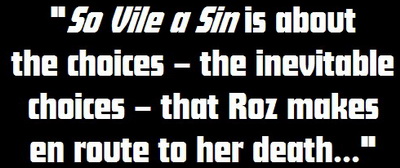|
| |
|
STORY PLACEMENT THIS STORY TAKES PLACE BETWEEN THE NOVELS "DAMAGED GOODS" AND "BAD THERAPY."
WRITTEN BY BEN AARONOVITCH & KATE ORMAN
RECOMMENDED PURCHASE OFFICIAL VIRGIN 'NEW ADVENTURE' PAPERBACK (ISBN 0-426-20484-0) RELEASED IN APRIL 1997.
BLURB The Earth Empire, on which a thousand suns never set, is
dying. the Empire manoeuvre and scheme; alliances are made; and knives flash in the shadows.
Out among the moons of Jupiter, another battle is beginning, as a brotherhood seeks power and
revenge.
to the 30TH century, searching for the source of a POWERFUL weapon. He fears a nightmare from his own past mIGHT be about to destroy the future. Nothing must be allowed to get in
his
way. reckoned without the power of history, which has ITS OWN PLANS for the House of Forrester'S MOST wayward daughter... |
|
|
So Vile a Sin APRIL 1997
The one that got away.
Like many other devotees of the New Adventures, I wasn’t fortunate enough to be able to read So Vile a Sin on its initial publication back in May 1997. By that time, Virgin had lost their Doctor Who licence, and so inevitably their final Who book sold out before it even hit the shops with no chance of a reprint. And along with Lungbarrow, The Dying Days, and a handful of other 1997 titles, copies of So Vile a Sin now regularly change hands for over ten times their cover price on eBay. This chump here had to fork out over fifty quid for his mint-condition copy and then read it wearing plastic gloves so as not to soil the pages, as well at a funny angle so as not to crease the spine. And the controversy doesn’t end there.
So Vile a Sin by Ben Aaronovitch was originally scheduled for a November 1996 release, alongside Gareth Roberts’ first Doctor novel The Plotters, however Aaronovitch encountered numerous complications in finishing the book, including a near-calamitous hard drive crash. Suffice it say that deadlines were not met and so New Adventures veteran Kate Orman was brought in to complete the task. So Vile a Sin barely managed to make publication, finally materialising in May 1997. The last of the New Adventures novels to feature the Doctor, So Vile a Sin is actually set in the gaping chasm between Russell T Davies’ Damaged Goods and Matt Jones’ Bad Therapy. If any of the New Adventures had to run into such difficulties, then in accordance with Murphy’s law it would be the one that a) concludes a multi-novel story arc; and b) features the death of a companion! Had So Vile a Sin been a mere pulp fiction filler, I get the distinct impression that it would never have made publication at all, but, as Orman put it, “I was so desperate to read this book that I’d even write it myself!”
The end result is breathtaking in its splendour, yet almost irredeemably baffling. Orman had to write a book that, to put it simply, she would never have written herself. Aaronovitch had plotted a vast, sweeping, space opera which only Orman’s partner Jonathan Blum could get his head around. Consequently, So Vile a Sin is not, for the most part, easy to follow, but one thing that it is throughout is fascinating. Orman’s prose fleshing out an Aaronovitch story is worth the purchase price in itself – the original £4.99 purchase price, that is – but what I found really enthralling was the way So Vile a Sin has the Doctor subjected to thousands of parallel quantum realities. Provided that it isn’t used as a continuity cop-out, I love the old, done-to-death ‘parallel universe’ idea, and never before have I seen it portrayed in such an innovative way. The Doctor doesn’t visit a parallel world here; he sees them. All of them. In his head. All the time. Everything that could ever be – possible futures, possible pasts – all the time, in his head. And it drives him absolutely mad.
also explore the cause and effect of travelling with the Doctor from Roz’s point of view. In So Vile a Sin, there are times where Roz remembers a new timeline that has been created by virtue of her adventures with the Doctor, yet she can still also remember not remembering. She remembers Yemaya 4 not existing in her youth, but then she and the Doctor saved it in her relative past, and so now it does exist in her present. And she remembers it always having been there. It’s absorbing stuff, to say the least.
This is also interesting from a continuity buff’s perspective. Even in this post-Zagreus age where it is argued that there are a multitude of quantum realities out there that weave and stray throughout all the Doctors’ lives, Big Finish productions have yet to really put the knife into the canonicity of the seventh Doctor’s New Adventures. Dust Breeding notwithstanding (which can be explained away with a bit of imagination and with reference to The Quantum Archangel), one could even argue that in light of The Shadow of the Scourge and The Dark Flame, Big Finish were actively endorsing the New Adventures. However, if in this novel the seventh Doctor can see all these parallels, it could be argued that the New Adventures are indeed an exclusive offshoot of the seventh Doctor’s timeline. In this novel’s really quite deep epilogue, the Doctor even repeatedly proclaims, “I’m the wrong one.”
Nevertheless, as fascinating as the Doctor’s dip into the multiverse is, the main thrust of the book drives the loose ‘psi-powers’ arc towards a surprisingly satisfying finale. I suppose if I were a hardened cynic I’d point out that any finale to this arc would have been satisfying by definition, as it would be bringing the damned thing to a close, but that would be doing this novel and certainly Damaged Goods a grave injustice. So Vile a Sin is often compared to Aaronovitch’s preceding New Adventures, but I think that it’s most similar to Andy Lane’s Original Sin – the novel that introduced us to Chris and Roz in the first place. The setting is the same, albeit fast-forwarded six or seven years (perhaps an indication as to how long they have both been travelling with the Doctor as he does tend to keep things relative), and structurally it shares the same sort of meandering, planet-hopping narrative.
There’s also a lot of political intrigue surrounding the Forrester family and the assassination of the Empress, as well as a fair bit of action as we meet another rampaging N-Form and the Brotherhood are finally given the opportunity to bring all their dastardly plans into fruition when a psi-gateway opens in the very fabric of the universe. It’s certainly complicated, and without knowledge of the foregoing novels it’s nigh on inconceivable that a reader would be able to make sense of it all. For the loyal reader though, at times it’s really quite rewarding. So Vile a Sin even speculates about the origins of the Gallifreyans – here it’s confirmed that they were the first sentient beings to evolve in this universe, and that before Rassilon, they were “the Shadow people, caught between the warm dark of magick and the cold light of science.” As the Gallifreyans became Time Lords and “rationalised” the universe, only one form of magick survived – psi…
Whilst reading the book I had a lot of trouble trying to ascertain the relevance of the book’s wonderfully elegiac title. However, once I had read the closing chapter, the Dauphin’s oft-cited line from Shakespeare’s Henry V seems wholly appropriate; it sums up not only the futility of Roz’s death but also the Doctor’s subsequent breakdown and descent into self-loathing.
“Self-love, my liege, is not so vile a sin as self-neglecting.”
I don’t think that I can stress enough just how moving the epilogue to the novel is; the heart Orman injects into it is absolutely staggering. Roz’s death isn’t shown; we simply see her charge off into battle as Pontifex Saecularis, Head of the Order of Adjudicators, never to return. And the Doctor knew it would happen. In fact, it’s heavily implied that he has always known. And it isn’t as if we didn’t see it coming, either – Roz was declared dead on page one of the novel and besides, just about everybody to read So Vile a Sin must have been aware of Roz’s death thanks to the chronologically-subsequent four books. So Vile a Sin is thus about the choices – the inevitable choices – that Roz makes en route to her death, and it’s about their haunting aftermath. The Doctor’s double-barrelled heart attack at the funeral. Chris Cwej’s uncharacteristically manifest despair. Bernice’s crippling realisation that the Doctor has run out of steam. That he’s “got nothing he wants to do, and no energy left to do it. He’s just waiting to die.” And die soon he will – not just in the literal TV Movie sense, but also in a metaphorical sense as the Virgin rug is pulled out from under him.
And so this
‘Missing’ New Adventure rounds off the ‘psi-powers’ story arc as
well as could be expected, and it certainly gives Roz one hell of a
memorable send off. But was it worth the fifty quid that I paid for it?
Is any book…?
|
|
|
Copyright © E.G. Wolverson 2006
E.G. Wolverson has asserted his right under the Copyright, Designs and Patents Act, 1988 to be identified as the author of this work. |
|
|
Unless otherwise stated, all images on this site are copyrighted to the BBC and are used solely for promotional purposes. ‘Doctor Who’ is copyright © by the BBC. No copyright infringement is intended. |
|

.jpg)
.jpg)

 More than that
though, the writers
More than that
though, the writers